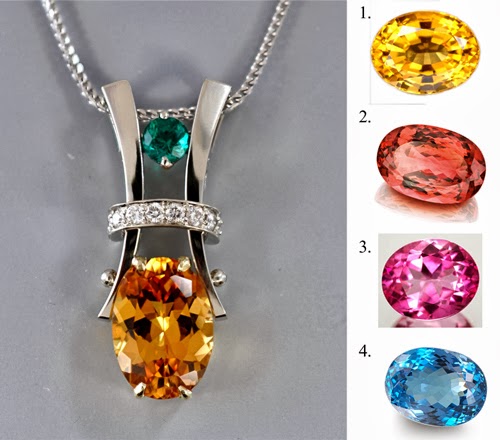Precious topaz is the birthstone of November.
Topaz has been a significant gemstone throughout history. Egyptians believed topaz got its color from the sun god, whom they called Ra, which made the stone highly prized among them. The Romans believed topaz got its coloring from the sun as well, which comes as no surprise given fiery range of colors it is found in. It is possible that this gem’s close association with the sun also stems from the belief that its mystical properties were stronger at different times of the month; particularly closer to a full moon.
During the plague of 1348, a number of victims were cured after being visited by Pope Clement the Sixth while he was wearing a huge topaz ring. Reporters from this time claim that it was the topaz that did the job, not Pope Clement.
The ancient Indian folk medicine, Ayurveda, recognizes topaz's curative powers; helpful in building heart tone, revitalizing circulation, preventing wrinkles and varicose veins, and keeping the skin young and fresh. It has also been reported to eliminate fear and insomnia. In China, topaz was hung on the doors of houses in the belief that the stone absorbed energy from the sun and transmitted health and serenity to all the members of the family.
There has been much confusion surrounding the name topaz for many years. The term “topaz” has loosely been used to describe a yellow gem, so at times citrine (see below), which is part of the quartz family, was described as topaz. Due to this issue, the distinction of precious (Figure #1) and imperial (Figure #2) topaz was made. Imperial topaz refers to stones with rich golden, deep pink, peach and reddish-orange colors. The less intense but still beautiful yellow, orange and medium golden hues are referred to as precious topaz.
The term "imperial" stems from the discovery of pink topaz (Figure #3) in Russia during the 19th century. The stone was instantly so coveted that ownership was restricted to the Czar, his family and those whom he gave it as a gift. Pink topaz today is the most valuable variety.
Blue topaz (Figure #4) is created through irradiation and is one of the least expensive stones. While there are natural blue topaz, they are extremely rare; the majority are irradiated.
While there are topaz deposits around the world including Russia, Sri Lanka, the United States, China and Pakistan, the best quality come from Brazil. The increased worldwide demand for this stone, as well as Brazil’s recent economic boom had caused prices for this stone to more than double. Prices for imperial topaz has increased 60-70% since 2007.
Given these increases, you may be wondering exactly what these prices are today. Blue topaz is the least expensive, ranging from $20-40 per carat. Following this is a large jump to precious topaz, which is around $200-$400 per carat. The prized imperial topaz goes for $500-$1000 per carat, while the most valuable pink topaz falls in the $1000- $1500 per carat range. If an imperial topaz is being sold for a very low price, you must be careful as it may have gone through special treatments which are reversible, causing it to lose its color very quickly.
Citrine is the alternative birthstone of November. Although it doesn't match the beauty of topaz, it costs much less; around $20- $60 per carat.
Topaz has a mohs rating of 8, making it a very hard stone. However, it should still be protected from hard knocks, as it may crack or split due to its perfect basal cleavage, which makes it vulnerable to breakage.
Pictured is a 6.9 carat imperial topaz pendant in white and yellow 18k gold with an emerald and diamonds, designed by Alex Gulko in 2011.
By Vicky Gulko

No comments:
Post a Comment